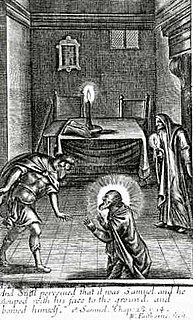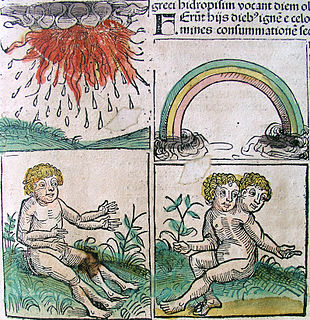
The tarot is a pack of playing cards, used from the mid-15th century in various parts of Europe to play games such as Italian tarocchini, French tarot and Austrian Königrufen. Many of these tarot card games are still played today. In the late 18th century, some Tarot packs began to be used in parallel for divination in the form of tarotology and cartomancy and, later, specialist packs were developed for such occult purposes.

Necromancy is a practice of magic involving communication with the dead – either by summoning their spirit as an apparition or raising them bodily – for the purpose of divination, imparting the means to foretell future events or discover hidden knowledge, to bring someone back from the dead, or to use the dead as a weapon, as the term may sometimes be used in a more general sense to refer to black magic or witchcraft.

Odinani comprises the traditional religious practices and cultural beliefs of the Igbo people of southern Nigeria. Odinani has monotheistic and panentheistic attributes, having a single God as the source of all things. Although a pantheon of spirits exists, these are lesser spirits prevalent in Odinani expressly serving as elements of Chineke, the supreme being or high god. Chineke is a compound word encompassing the concept of chí is the creator (nà) is a verb meaning 'that' while ékè means create. Chineke therefore means the Creator or the God that created all things. The concept of Chúkwú was largely propagated by the Aro-Igbo of Arochukwu in eastern Igboland who wielded much spiritual force over the eastern Niger Delta in the 18th century due to their operating of the Ibini Ukpabi oracle.

An omen is a phenomenon that is believed to foretell the future, often signifying the advent of change. People in ancient times believed that omens bring a divine message from their gods.
Pyromancy is the art of divination by means of fire.

African art describes the modern and historical paintings, sculptures, installations, and other visual culture from native or indigenous Africans and the African continent. The definition may also include the art of the native African, African diasporas, such as African American, Caribbean and other American art. Despite this diversity, there are some unifying artistic themes when considering the totality of the visual culture from the continent of Africa.

Oracle bones are pieces of ox scapula or turtle plastron, which were used for pyromancy – a form of divination – in ancient China, mainly during the late Shang dynasty. Scapulimancy is the correct term if ox scapulae were used for the divination; plastromancy if turtle plastrons were used.
Cleromancy is a form of sortition, casting of lots, in which an outcome is determined by means that normally would be considered random, such as the rolling of dice, but are sometimes believed to reveal the will of God, or other supernatural entities.
Cowrie-shell divination refers to several distinct forms of divination using cowrie shells that are part of the rituals and religious beliefs of certain religions. Though best-documented in West Africa as well as in Afro-American religions, such as Santería, Candomblé, and Umbanda, cowrie-shell divination has also been recorded in other regions, notably East Africa and India.

Alectryomancy is a form of divination in which the diviner observes a bird, several birds, or most preferably a white rooster or cockerel pecking at grain that the diviner has scattered on the ground. It was the responsibility of the pullularius to feed and keep the birds used. The observer may place grain in the shape of letters and thus discern a divinatory revelation by noting which letters the birds peck at, or the diviner may just interpret the pattern left by the birds' pecking in randomly scattered grain.

Astragalomancy, also known as astragyromancy, is a form of divination that uses dice specially marked with letters or numbers.
The traditional African religions are a set of highly diverse beliefs that include various ethnic religions. Generally, these traditions are oral rather than scriptural, include belief in a supreme creator, belief in spirits, veneration of the dead, use of magic and traditional medicine. The role of humanity is generally seen as one of harmonising nature with the supernatural. According to Lugira, "it is the only religion that can claim to have originated in Africa. Other religions found in Africa have their origins in other parts of the world."
Renaissance humanism saw a resurgence in hermeticism and Neo-Platonic varieties of ceremonial magic.

Santería, also known as Regla de Ocha, La Regla de Ifá, or Lucumí, is an Afro-American religion of Yoruba origin that developed in Cuba among West African descendants. Santería is a Spanish word that means the "worship of saints". Santería is influenced by and syncretized with Roman Catholicism. Its sacred language is the Lucumí language, a remnant of Yoruba language that is used in rituals but no longer spoken as a vernacular and mostly not understood by practitioners.

The Sandobele are members of the Sandogo, an authoritative women’s society of the Senufo people, who practice divination. The Senufo inhabit the savannas and tropical rain forests of northern Côte d'Ivoire and the nearby land in Mali and Burkina Faso. The Sandogo is responsible for sustaining positive relationships with the spirit world through divination and for protecting the purity of each kinship group. The word Sandobele originates from the Senufo language.

Greek divination is divination, which is a type of magic, as performed historically in ancient Greek culture.

African divination is divination practiced by cultures of Africa.














